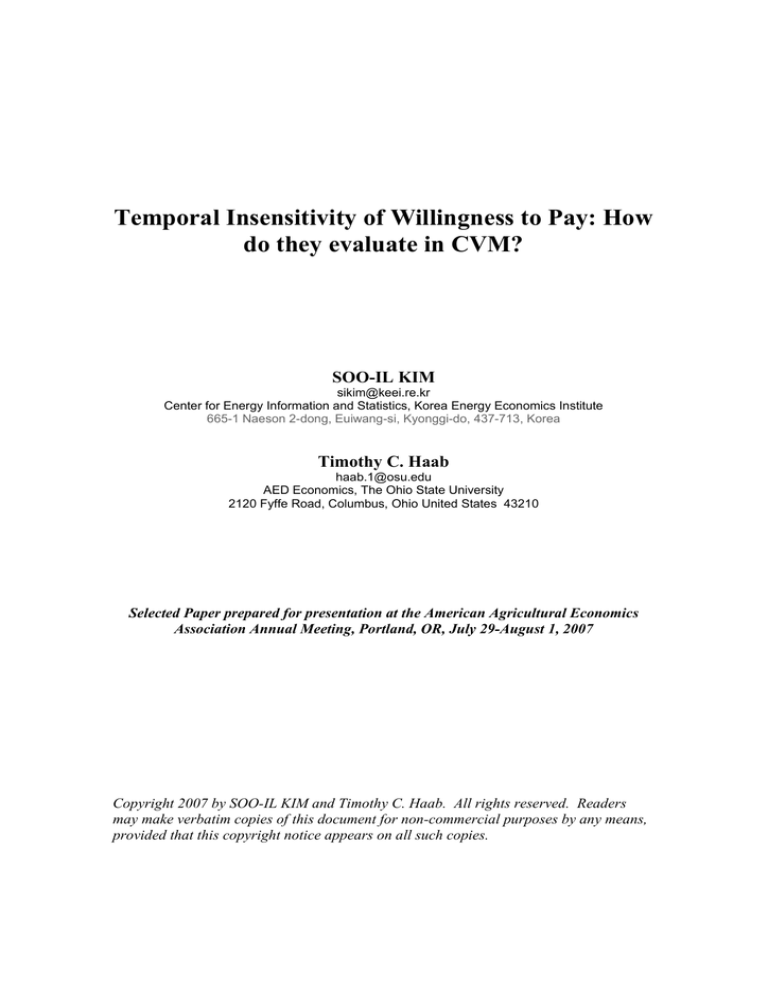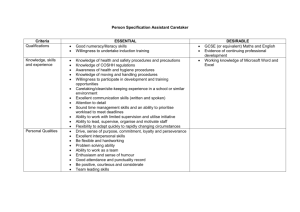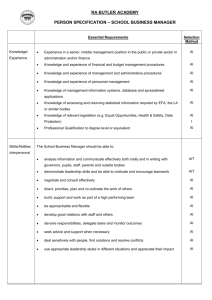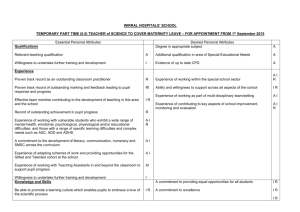
Temporal Insensitivity of Willingness to Pay: How
do they evaluate in CVM?
SOO-IL KIM
sikim@keei.re.kr
Center for Energy Information and Statistics, Korea Energy Economics Institute
665-1 Naeson 2-dong, Euiwang-si, Kyonggi-do, 437-713, Korea
Timothy C. Haab
haab.1@osu.edu
AED Economics, The Ohio State University
2120 Fyffe Road, Columbus, Ohio United States 43210
Selected Paper prepared for presentation at the American Agricultural Economics
Association Annual Meeting, Portland, OR, July 29-August 1, 2007
Copyright 2007 by SOO-IL KIM and Timothy C. Haab. All rights reserved. Readers
may make verbatim copies of this document for non-commercial purposes by any means,
provided that this copyright notice appears on all such copies.
Temporal Insensitivity of Willingness to Pay: How do they evaluate in
CVM?
Abstract: In addition to scope and scale embedding effects, temporal insensitivity of
willingness to pay, also known as temporal embedding effect, has been a well known
anomaly in eliciting willingness to pay for environmental quality change, especially over
time. Stevens et al. (1997) defines two types of temporal embedding effects: strong
insensitivity and weak insensitivity to payment schedule. This paper proposes an
alternative definition of the temporal insensitivity. Temporal insensitivity implies that a
subject in the survey responds consistently to value elicitation questions regardless of
payment schemes. The sequential test tests the temporal insensitivity using the oyster reef
restoration programs in Chesapeake Bay. Test results show that willingness to pay for the
program is insensitive to the payment scheme or to the length of benefit stream of the
project. Discount rates imbedded in cost stream vary significantly among the combination
of project lengths and payment schemes.
Keywords: Temporal insensitivity of willingness to pay, Temporal embedding effect,
Implicit discount rate, Sequential test
1. Introduction
In addition to scope and scale embedding effects, temporal insensitivity of
willingness to pay, also known as temporal embedding effect, has been a well known
anomaly in eliciting willingness to pay for environmental quality change, especially over
time. Stevens et al. (1997) defines two types of temporal embedding effects: strong
insensitivity and weak insensitivity to payment schedule. Strong insensitivity to payment
schedule indicates the inability of respondents to differentiate between a series of
payments and a lump sum payment on the project, and weak insensitivity implies
inequality of willingness to pay’s between two temporally differentiated payment
schemes but abnormally high implicit discount rates.
Kahneman and Knetsch (1992) find evidence of strong insensitivity of median
willingness to pay in the study of a toxic waste treatment facility. In their study,
respondents showed the same lump sum median willingness to pay ( WTPL ) and annual
willingness to pay ( WTPt ) over a five-year payment scheme. On the other hand, a series
of papers (Rowe et al. 1992, Stevens et al. 1997, Ibáñez and McConnell 2001, Bond et al.
2002) has rejected strong insensitivity but found weak insensitivity of willingness to pay
with high discount rates ranging from two digits to several thousand percent. In fact,
relatively high implicit discount rates have been observed in experimental research as
well (Harrison and Johnson, 2002; Harrison et al., 2002; Coller et al., 2002).
Previous literature of temporal insensitivity, however, discovered their findings
under too strict assumption on the underlying decision process of a subject. The strong
assumption, specifically consistence and homoskedasticity of present value of willingness
to pay over the payment schemes, can skip over comparison or identification problem.
Furthermore, the definition of weak insensitivity is under debate since there is no
consensus about an abnormally “high” discount rate.
In this paper, we propose the concept of temporal willingness to pay and test the
temporal consistence and invariance of willingness to pay. Chapter 2 describes the
example study of environmental change and the concept of temporal insensitivity of
willingness to pay. Chapter 3 provides the context of temporal willingness to pay and
methodological development of estimation and test of temporal insensitivity. Chapter 4
shows the application result and Chapter 5 briefly summarizes findings and conclusion.
1
2. Temporal Insensitivity and Implicit Discount Rates
2.1 Benefit Stream and Cost Stream in Contingent Valuation Study
Environmental projects, by their nature, include temporal dimension of benefits
and costs that may or may not be considered by researcher. To provide the context of
temporal issue in the contingent valuation study, we start by describing a typical
contingent valuation application for environmental change over time.
In 2002, the Chesapeake Bay Foundation commissioned a study to measure the
benefits from an oyster reef restoration project in Chesapeake Bay in Maryland (for
details, see Haab et al. 2004). The oyster program has the hypothetical restoration target
of 10,000 acres for oyster habitat and 1,000 acres for artificial reef. The survey context
presented explicitly to respondents that the benefit stream from the ten-year (five-year)
project would be increasing number of oysters in accordance with accumulation of reef
restoration at the rate of 100 (200) acres and habitat preservation at the rate of 1,000
(2,000) acres per year. Each restoration program employed one of three payment
schemes: a one-time (lump sum) payment on next year’s state tax, annual payments over
the life of the project, and permanent annual payments. Among six designs (2 project
lengths and 3 payment schemes), one scenario was randomly offered to respondents.
Thus, for example, respondents to the five-year project scenario with one-time payment
were presented the following question1,
The restoration program is estimated to cost your household a total of $___. Your household
would pay this as a special one time tax added to next year’s State income tax. If an election
were to be held today and the total cost to your household was $___ would you vote for
or against the 5 year restoration program (Check one)?
I would vote for the program
I would vote against the program
I do not know whether I would vote for or against the program
2.2 Reviews on Temporal Insensitivity
Let the benefit that the respondent would get in each year be Bt , where t = 1, 2,…,
TB , and the cost that he or she have to pay be Ct , where t = 1, 2,…, TC . The series of
benefit/cost pairs ( Bt , Ct ) fully describes the project. For facilitating the contingent
1
For the conservative reason, ‘I don’t know’ response is assumed to be ‘vote against’ response (Carson et
al. 1998, Groothuis and Whitehead 1998). Thus, the response is of binary choice format.
2
valuation study, respondents are assumed to have a well-defined value of Bt that they can
compare with the monetary value of costs2. Annual willingness to pay constrained by the
current period budget is the theoretical measurement of the well-defined value of the
benefit stream, which are derived from either of the time-separable annual utility
framework (Stevens et al. 1997) or the time-separable willingness to pay framework
(Bond et al. 2002).
Let WTPt A be the annual willingness to pay in t-th year, then the present value of
willingness to pay, PVWTP, becomes
PVWTP = ∑ t =1WTPt A (1 + r )
T
− ( t −1)
(1)
where r is the social discount rate. Most contingent valuation applications employed the
terminal period of cost stream for aggregating discounted willingness to pay. By the same
logic, the monetary value of cost stream is defined by the present value of costs, PVC:
PVC = ∑ t =1 Ct (1 + r )
T
−( t −1)
.
(2)
Now, we have the formal definition of temporal insensitivity of willingness to pay.
Let WTP L be the lump sum willingness to pay for a project (i.e. the present value of
willingness to pay in the lump sum payment schedule). The strong insensitivity is defined
by WTP L = WTP1A = WTP2A = L = WTPTA , i.e. an infinite discount rate. Strong insensitivity
to payment schedule indicates the inability of respondents to differentiate between a
series of payments and a lump sum payment on the project. The weak insensitivity is
defined by the existence of WTP L = PVWTP with abnormally high discount rate (Stevens
et al. 1997). In their work, Stevens et al. (1997) estimated lump-sum willingness to pay
and annual willingness to pay, and derived the implicit discount rate from
WTP L = PVWTP after the test of difference between lump-sum willingness to pay and
annual willingness to pay. Bond et al. (2002) calculated the implicit discount rate with the
assumption of consistent and homoskedastic willingness to pay across different payment
schemes.
2
For convenience and simplicity, respondents are assumed to have well defined monetary value of benefit
stream. In fact, well-defined range of values is enough for comparison and the value of benefit does not
have to be a monetary unit. The decision is made by comparing the benefit and cost in terms of the same
but any plausible unit.
3
We have concerns in previous literature, especially about the consistence of
willingness to pay across different payment schemes. For example, the difference of
lump-sum willingness to pay and annual willingness to pay in Stevens et al. (1997) did
not imply the equality of lump-sum willingness to pay and the present value of
willingness to pay, which is also valid in Bond et al. (2002) when they estimated the
implicit discount rate. Note that the benefit stream can be subjective due to individual
confidence in the program, uncertainty of the future, different cognizance about the
survey description, etc. The life of benefit stream may also be different in the
respondent’s perception even though the contingent valuation survey describes explicitly
the life of the project. If the willingness to pay varies with different payment schemes,
there is a design effect on respondents’ response, which is defined as temporal
inconsistence of willingness to pay. Without the consistence of willingness to pay, we
cannot compare lump-sum willingness to pay and present value of willingness to pay.
The second estimation problem is the heteroskedasticity across different payment
schemes. In parametric estimation, random utility function or willingness to pay function
assumes an additive error term with constant variance across different payment schemes.
Since estimation models for binary choice normalize parameters by its standard deviation,
this assumption leads miscalculation of implicit discount rate if violated.
3. Consistence of Willingness To Pay and Sequential Test
3.1 Theoretical Model
For clear understanding temporal inconsistence and heteroskedasticity of
willingness to pay, we introduce a theoretical model of deriving willingness to pay and
estimating implicit discount rate. Let U t be the utility from the benefit Bt at time t. Then,
for the lump-sum payment scheme, the willingness to pay, i.e. the consumer surplus, for
the environmental change is measured by the maximum payment equating two equations
below,
U1 ( x, y ) + δ U 2 ( x, y ) + δ 2U 3 ( x, y ) + δ 3U 4 ( x, y ) +L
U1 ( x, B1 , y − M 1 ) + δ U 2 ( x, B2 , y ) + δ 2U 3 ( x, B3 , y ) + δ 3U 4 ( x, B4 , y ) +L
4
(3)
(4)
where equation (3) is the status quo utility stream and equation (4) is the utility stream
with environmental change. For simplicity, we assume that income and other
characteristic variables are constant over time3.
With the linearity of utility in income and constant income elasticity, the
willingness to pay is
WTP L =
1
( ΔU
α
1
+ δΔU 2 + δ 2 ΔU 3 + L + δ TB −1ΔU TB
)
(5)
where ΔU t = U t ( x, Bt ) − U t ( x ) and α is the income elasticity. By the same logic, the
willingness to pay with the TC -period annual payment scheme becomes
WTP1A + δ WTP2A + L + δ TC −1WTPTCA =
1
( ΔU
α
1
)
+ δΔU 2 + δ 2 ΔU 3 + L + δ TB −1ΔU TB . (6)
Cleary, the present value of willingness to pay, the left-hand side of equation (5) and (6),
is discounted up to the life of cost stream and the corresponding benefit stream named by
the present value of utility difference, the right-hand side of equation (5) and (6), is the
one discounted up to the life of benefit stream.
The consistence of willingness to pay comes from the identical expression of the
present value of utility difference. However, the consistence should be tested before
deriving the implicit discount rate and concluding temporal insensitivity since the
inequality of WTP L and WTPt A does not imply the equality of the present value of utility
differences. Previous framework of willingness to pay ( WTPt = x′t β + εt ) cannot identify
the present value of willingness to pay due to unknown discount factor, which makes it
impossible to test the consistence of willingness to pay. Random utility function
framework ( ΔU t = x′t β + ε t ) also has the complicate problem because the present value of
utility difference is discounted up to the life of benefit stream but the present value of
cost is the discounted sum up to terminal period of costs.
In this paper, we directly specifies the present value of utility difference in the
right-hand side of equation (5) or (6) as a function of the set of full benefit stream and
3
The random utility at each period varies depending on the individually perceived benefit stream and timeevolving characteristics of respondents. Although respondents are assumed to have constant covariates,
linear additive specification of the model requires strong assumptions about the temporal properties of the
error terms.
5
current individual specific covariates. The value of the benefit stream, which we name
temporal willingness to pay (TWTP), is now defined by
TWTP ≡
1
( ΔU
α
1
+ δΔU 2 + δ 2 ΔU 3 + L + δ TB −1ΔU TB
)
= f ( π , x, β ) + ε
{
(7)
}
where π = B1 , B2 ,..., BTB is the benefit stream of the environmental project. The error
term, ε i , may be conditional on the project type and payment schemes. Instead of
calculating the present value of annual willingness to pay’s stream, temporal willingness
to pay assumes that respondents construct the willingness to pay from the view of the
entire benefit stream. This may be a reasonable and realistic valuation structure of how
individual respondent think of an environmental project proposed in a survey. Since
temporal willingness to pay is a lump-sum value that an individual may have at the time
of survey, temporal willingness to pay does not require the researcher to sum the
discounted errors across time or impose restrictions on the temporal relation of multiperiod error terms4. In addition, temporal willingness to pay formulation is flexible in the
functional form of the systematic component.
Contrary to previous literature, we define consistence and homoskedasticity of
willingness to pay across payment schemes by temporal insensitivity of willingness to
pay. From the temporal willingness to pay, the temporal consistence of willingness to pay
is defined by
TWTPl = TWTP k
(8)
where l and k represent different payment scheme. Temporal insensitivity of willingness
to pay indicates that respondents have a consistent valuing mechanism that is not
influenced by outside factors such as the payment scheme.
3.2 Choice Probability and Estimation Model
Respondents vote for the proposed project in contingent valuation study when the
temporal willingness to pay is greater than the value of the cost stream for a project that
4
Temporal willingness to pay may be time-dependent in the sense that it can vary depending on the timing
of the survey. However, Carson et al. (1997) show that CV estimates exhibited no significant sensitivity to
the timing of interviews.
6
is typically defined by the present value. With the linear model specification for the
temporal willingness to pay and the functional assumption of the error term, the
conditional probability that a respondent will vote for a program k given the payment
version j is defined by
P ( vote for k | j ) = P (TWTPj ,k ≥ PVC j ) = P ( x′β j ,k + ε j ,k ≥ φ j C j )
where φ j C j = ∑ t =C1 C j (1 + r )
T
(
− ( t −1)
(9)
, the discount factor is φ1 = 1 for a lump sum payment
scheme(j = 1), φ2 = 1 + r − (1 + r )
−TC −1
) / r for annual payment over T
C
years (j = 2), and
φ3 = (1 + r ) / r for perpetual payment (j = 3) when the discount rate is positive. The
probability of vote against is defined as the complement to the probability of vote for.
Generally, the variance of the error term is conditional on the project version (k) and
payment scheme (j).
When temporal willingness to pay is consistent but heteroskedastic across
different payment schemes, we can estimate the model using dummies for cost variable,
which is named by rescaled model. The rescale factor is the variance of one sub-sample
(e.g. lump-sum payment) and the model estimates the relative variances of the other
groups (e.g. annual payment). The positive standard deviation is defined by
σ j = σ exp ( λ ′d j ) , where σ is the standard error of lump-sum payment scheme. If λ = 0 ,
i.e. homoskedastic error term, then we can estimate the model simply by combining data
without rescale factor.
3.3 Sequential Test for the Temporal Insensitivity
A sequential test proposed by Swait and Louviere (1993) for combining data from
different data sources provides a context for testing consistency and homoskedasticity of
temporal willingness to pay5. The null hypothesis of the sequential test for consistence
and homoskedasticity of temporal willingness to pay across payment schemes is:
⎧ βl = β m ⎫
H0 = ⎨
⎬
⎩σ l = σ m ⎭
5
(10)
Haab et al. (1999) employed the sequential test in the contingent valuation study and found that correcting
heteroskedasticity provided statistically consistent willingness to pay under real and hypothetical formats.
7
where β is the parameter set of the temporal willingness to pay function, and l and m
indicate payment schemes. The composite hypothesis tests the consistence of temporal
willingness to pay ( H 0A = {β l = β m } ) without restriction on variances across payment
schemes in the first stage. The model under the null hypothesis is rescaled model.
Rejection of the first hypothesis indicates that the value of the environmental project
varies depending on the payment scheme.
Conditional on the failure to reject the first hypothesis, the second step is to test
homoskedasticity across payment schemes ( H 0B = {σ l = σ m } ). The unrestricted model in
the second stage is the scaled model in the first stage. The restricted model in the second
stage is the pooled model stacking all samples across payment schemes with equal
parameters in temporal willingness to pay and dummies for payment scheme.
3.4 Implicit Discount Rates from the Consistent Willingness To Pay
If both stages of the sequential test fail to be rejected, the implicit discount rate is
derived simply from pooled data across payment schemes. Let φ%j be the normalized
estimate for cost of payment scheme j. The implicit discount rate is the solution to the
nonlinear function
⎤
φ%2 ⎛ 1 + r1,2 ⎞ ⎡⎢
1
⎥
=⎜
−
1
⎟
φ%1 ⎜⎝ r1,2 ⎟⎠ ⎢ (1 + r1,2 )T ⎥
C
⎣
(11)
⎦
when we have lump-sum and annual payment schemes. With lump-sum payment and
perpetual annual payment schemes, the implicit discount rate is
r1,3 =
φ%1
φ%3 − φ%1
.
(12)
If the first hypothesis fails to be rejected but the second hypothesis is rejected, the
implied discount rate is derived from rescaled model,
⎛ 1 + r1,2 ⎞ ⎡
φ%2
1
1
⎢1 −
=
⎜
⎟
φ%1 exp λˆ2 d 2 ⎜⎝ r1,2 ⎟⎠ ⎢ (1 + r1,2 )T
⎣
(
)
C
for lump-sum payment scheme and annual payment scheme, or
8
⎤
⎥
⎥
⎦
(13)
⎛ 1 + r1,3 ⎞
φ%3
1
=
⎜
⎟
φ%1 exp λˆ3d3 ⎜⎝ r1,3 ⎟⎠
(
)
(14)
for lump-sum and perpetual-type payment schemes. Note that temporal willingness to
pay is still time-consistent in spite of the heteroskedastic error term.
4. An Application to Oyster Reef Restoration Program
To test the temporal sensitivity of willingness to pay and to estimate implicit
discount rate, we apply the temporal willingness to pay and sequential test to the oyster
reef restoration project in the Chesapeake Bay. As described before, the mail survey
consisted of a split-sample design with two temporal versions of the hypothetical project
(A for the five-year project and B for the ten-year project) and three types of payment
scheme (1 for lump-sum payment, 2 for annual payment, and 3 for perpetual type). The
estimation model assumed a normal distribution for the error term.
Table 1 shows estimation results for the five-year project. FEE1, FEE2A and
FEE3 represent payment vectors for one-time, annual payment for five years and
perpetuity-type payment, respectively. The first three columns of Table 1 exhibit the
estimation result for individual payment scheme. The other columns show the result of
rescaled and pooled models for several combinations of payment schemes. Temporal
willingness to pay for five-year project ranged US$263~277. Table 2 provides test
statistics for the sequential test on the five-year project. With 95% confidence, LR test
failed to reject the consistence and heteroskedasticity of temporal willingness to pay of
five-year project.
[Table 1~2 located here]
Table 3 and Table 4 also provide estimation results for the data pooled over five
and ten-year restoration programs6. The expected temporal of willingness to pays were
$216~234 for five-year project and $181~198 for ten-year project in combined data.
Table 3, however, shows that the temporal willingness to pay for the ten-year project is
6
We assumed consistence and homoskedasticity of temporal willingness to pay of different projects. Thus,
the difference between five- and ten-year projects is estimated by the dummy for the project version.
9
statistically indistinguishable from that of the five-year project. Indifference of temporal
willingness to pay across project versions implies that respondents may evaluate the
project based on the final status of the environment but do not care how fast the project is
implemented. Table 4 demonstrates that temporal willingness to pay for the oyster reef
program is consistent except one case of combining lump-sum payment and perpetuitytype payment schemes. The rejection of hypothesis may be due to problematic features of
data violating monotonic probability (Cooper and Loomis 1992, Kanninen, 1995). Except
the case of rejecting the first stage hypothesis, for which the second stage test was not
necessary, the sequential test could not reject the homoskedastic error terms across
payment schemes.
[Table 3~4 located here]
Test results of oyster reef restoration program support that temporal willingness to
pay for the oyster reef programs was insensitive, i.e. consistent and homoskedastic, to the
payment scheme provided by researcher. Based on the sequential test results, Table 5
shows the implicit discount rate from parameter estimates of payment. Implicit discount
rates ranged from 20% to 130%. Estimated discount rates were still relatively high but
much lower than previous studies. Similar to hyperbolic discounting (e.g., see Cropper
and Laibson 1999), the short term discount rate (or near-term discount rate, r1A ) was
larger than the long term discount rate (or distant-term discount rate, r13 ) for the five-year
project only.
[Table 5 located here]
7. Conclusions
In spite of the simple concept of temporal insensitivity of willingness to pay,
previous studies derived the temporal insensitivity and implicit discount rate under
restrictive assumption that the present value of willingness to pay is identical across
different payment schemes. However, identification of present value of willingness to
pay and estimation of the discount rate from different payment schemes rely critically on
10
the consistent and homoskedastic present value of willingness to pay in payment context.
Especially, inconsistence present value of willingness to pay leads to inability of deciding
temporal insensitivity.
In this paper, we constructed the model of temporal willingness to pay and
redefined the temporal insensitivity by consistence and homoskedasticity of temporal
willingness to pay. The temporal insensitivity of willingness to pay implies the consistent
valuing behavior of respondents with different payment schemes. Using the sequential
test, we tested the consistence and homoskedasticity of the temporal willingness to pay
for oyster reef programs in Chesapeake Bay. The test results showed that the temporal
willingness to pay for the project was statistically identical across different payment types.
In holding the payment scheme constant, however, temporal willingness to pay did not
vary significantly across project versions. Homoskedasticity of the error distribution
across payment schemes supported the use of pooled data over payment schemes to
derive implicit discount rates. Estimated discount rates were relatively high but lower
than that of previous studies. Implicit discount rates varied significantly across payment
schemes and project versions.
11
References
Bond, C.A., K. Giraud, and D. Larson, 2002, “Temporal Payment Issues in Contingent
Valuation Analysis,” presented in AAEA meeting in Long Beach, California.
Carson, R.T., W.M. Hanemann, R.J. Kopp, J.A. Krosnick, R.C. Mitchell, S. Presser, P.A.
Ruud, and V.K. Smith with M. Conaway and K. Martin, 1997, “Temporal Reliability of
Estimates from Contingent Valuation.” Land Economics, 73 (2): 151-63.
Carson, R.T., W.M. Hanemann, R.J. Kopp, J.A. Krosnick, R.C. Mitchell, S. Presser, P.A.
Ruud, and V.K. Smith with M. Conaway and K. Martin, 1998, “Referendum Design and
Contingent Valuation: The NOAA Panel’s No-Vote Recommendation,” Review of
Economics and Statistics, 80, 335-338.
Coller, M., G.W. Harrison, E.E. Ruström, 2002, “Dynamic Consistency in the
Laboratory,” unpublished.
Cooper, J.C. and J. Loomis, 1992, “Sensitivity of Willingness-to-Pay Estimates to Bid
Design in Dichotomous Choice Contingent Valuation Models,” Land Economics 68(2),
211-24.
Crocker, T.D., and J.F. Shogren. 1993. “Dynamic Inconsistency in Valuing
Environmental Goods.” Ecological Economics, 7, 239-54.
Cropper, M., D. Laibson, 1999, “The Implication of Hyperbolic Discounting for Project
Evaluation” in Discounting and Intergenerational Equity by Weyant. Washington, DC:
Resources for the Future.
Diamond, P.A. and J.A. Hausman. 1994. “Contingent Valuation: Is Some Number Better
Than No Number?” Journal of Economic Perspectives, 8 (4), 45-64.
Groothuis and Whitehead, “Does Don’t Know Mean No? Analysis of ‘Don’t Know’
Responses in Dichotomous Choice Contingent Valuation Question,” unpublished, 1998.
Haab, T.C., J. Huang, J.C. Whitehead., 1999, “Are Hypothetical Referenda Incentive
Compatible? A Comment,” Journal of Political Economy, 107 (1), 186-196.
Haab, Hicks and Lipton, 2004, The Economic Benefits of Oyster Reef Restoration in the
Chesapeake Bay, Chesapeake Bay Foundation.
Hanemann, W.M., 1994, “Valuing the Environment Through Contingent Valuation.”
Journal of Economic Perspectives, 8 (4), 19-43.
Harrison, G.W., and E. Johnson, 2002, “Estimating Individual Discount Rates for the
United States: Inferences from a Natural Field Experiment,” unpublished.
12
Harrison, G.W., M.I. Lau, M.B. Williams, 2002, “Estimating Individual Discount Rates
in Denmark: A Field Experiment,” Forthcoming, American Economic Review, 92.
Ibáñe, A.M., and K. McConnell, 2001, “Scheduling Payments and Discount Rates:
Implication for Contingent Valuation in Developing Countries,” unpublished.
Kahneman, D., and J.L. Knetsch, 1992, “Valuing Public Goods: The Purchase of Moral
Satisfaction,” Journal of Environmental Economics and Management, 22(1), 55-70.
Kanninen, B.J., 1995, “Bias in Discrete Response Contingent Valuation,” Journal of
Environmental Economics and Management, 28, 114-125.
Mitchell, R.C., and R.T. Carson, 1989, Using Surveys to Value Public Goods: The
Contingent Valuation Method. Washington, DC: Resources for the Future.
Rowe, R.D., W.D. Shaw, and W. Schulze, 1992, “NESTWCCA Oil Spill,” in Natural
Resource Damages: Law and Economics, eds. K. Ward and J. Duffield. New York: John
Wiley and Sons.
Smith, V.K., 1992, “Comment: Arbitrary Values, Good Causes and Premature Verdicts.”
Journal of Environmental Economics and Management, 22(1), 71-89.
Stevens, T., N. DeCoteau, and C. Willis, 1997, “Sensitivity of Contingent Valuation to
Alternative Payment Schedules.” Land Economics, 73 (1), 140-148.
Swait, J. and J. Louviere, 1993, “The Role of the Scale Parameter in the Estimation and
Comparison of Multinomial Logit Models.” Journal of Marketing Research, 30, 305-14.
Thaler, R., 1981, “Some Empirical Evidence on Dynamic Inconsistency.” Economic
Letters, 8: 201-7.
13
Table 1: Estimation Results for Five-Year Project
Split Sample
1+2+3
1+3
1+2
A1
A2
A3
Scaled
Pooled
Scaled
Pooled
Scaled
Pooled
-0.8726
(1.0970)
-0.5018*
(0.2050)
0.2077
(0.1367)
0.1370
(0.2842)
0.0429*
(0.0121)
-0.0226
(0.0504)
0.0033*
(0.0015)
2.1975
(1.2577)
-0.1448
(0.1674)
-0.0918
( 0.1477)
0.5178
(0.3229)
0.0074
(0.0130)
-0.1074
(0.0624)
0.9891
(1.4054)
-0.3698
(0.2059)
0.0296
(0.0864)
-0.0473
(0.3483)
-0.0053
(0.0105)
0.0554
(0.0673)
—
—
-0.0230
(0.6874)
-0.3510*
(0.1384)
0.0605
(0.0687)
0.1795
(0.2059)
0.0164*
(0.0070)
0.0224
(0.0358)
0.0034*
(0.0012)
—
0.0059
(0.0042)
—
—
—
-0.0082
(0.6664)
-0.4227*
(0.1564)
0.1247
(0.1069)
0.2597
(0.2419)
0.0342*
(0.0095)
-0.0421
(0.0390)
0.0037*
(0.0013)
0.0049
(0.0045)
0.3011
(0.7991)
-0.3031*
(0.1267)
0.0775
(0.0983)
0.2585
(0.2038)
0.0254*
(0.0086)
-0.0458
(0.0375)
0.0029*
(0.0012)
0.0058
(0.0032)
FEE3
—
—
0.0152*
(0.0072)
0.4940
(0.6379)
-0.2759*
(0.1053)
0.0355
(0.0628)
0.2028
(0.1684)
0.0140*
(0.0062)
-0.0100
(0.0317)
0.0032*
(0.0010)
0.0064*
(0.0029)
0.0103*
(0.0046)
-0.3034
(0.9232)
-0.4685*
(0.1732)
0.1196
(0.0977)
0.2163
(0.2481)
0.0282*
(0.0093 )
0.0097
(0.0449)
0.0041*
(0.0014)
FEE2A
0.2993
(0.8034)
-0.3956*
(0.1390)
0.0734
(0.0848)
0.2607
(0.2124)
0.0229*
(0.0080)
-0.0114
(0.0393)
0.0041*
(0.0012)
0.0063
(0.0042)
0.0108
(0.0065)
0.0092
(0.0076)
0.0112*
(0.0052)
—
—
Scale Factors
—
—
—
0.4645
—
—
—
0.4850
—
0.4266
—
0.5620
—
—
—
Const
RE
HS
SEX
AGE
EDUC
FEE1
N
Mean ln(L)
101
83
73
257
-0.5635
-0.5852
-0.5566
-0.5992
174
-0.6015
-0.5900
184
-0.5930
-0.5913
-0.5951
* significant at 95% confidence level.
SEX is a dummy variable that is one for female. HS, AGE and EDUC are the size of household, age and education variables. RE is an ordinal variable for ranking
the role of oysters among food, economy, environment and fish habitat. RE = 1 represents that respondent thinks environment is the most important role oysters
play in the Chesapeake Bay.
14
Table 3: Estimation Results for Five and Ten-Year Projects
Split Sample
1+2+3
1+3
1+2
AB1
AB2
AB3
Scaled
Pooled
Scaled
Pooled
Scaled
Pooled
-1.0353
(0.7997)
0.2757
(0.1936)
-0.2667*
(0.1327)
0.0421
(0.0812)
0.0567
(0.1992)
0.0316*
(0.0077)
0.0351
(0.0374)
0.0048*
(0.0011)
1.3334
(0.9163)
-0.0821
(0.4350)
-0.1177
(0.1454)
-0.1169
(0.0977)
0.1954
(0.2202)
0.0004
(0.0086)
-0.0068
(0.0393)
1.1250
(0.8959)
-0.0198
(0.2183)
-0.1781
(0.1320)
-0.0620
(0.0678)
-0.3929
(0.2289)
-0.0057
(0.0077)
0.0426
(0.0419)
—
—
-0.0615
(0.5691)
0.1361
(0.1419)
-0.1632
(0.0903)
-0.0300
(0.0508)
-0.0911
(0.1446)
0.0134*
(0.0051)
0.0376
(0.0272)
0.0043*
(0.0009)
—
—
—
—
FEE2B
—
0.0059
(0.0041)
0.0096
(0.0059)
—
—
-0.3877
(0.6948)
0.2264
(0.1841)
-0.2522*
(0.1132)
-0.0074
(0.0717)
0.1220
(0.1700)
0.0248*
(0.0066)
0.0270
(0.0319)
0.0051*
(0.0010)
0.0081*
(0.0041)
0.0079
(0.0054)
-0.0870
(0.5859)
0.1904
(0.1714)
-0.1901*
(0.0950)
-0.0179
(0.0615)
0.0960
(0.1431)
0.0178*
(0.0056)
0.0166
(0.0265)
0.0042*
(0.0008)
0.0081*
(0.0029)
0.0082*
(0.0039)
FEE3
—
—
0.0068
(0.0048)
0.2748
(0.4772)
0.1038
(0.1336)
-0.1595*
(0.0760)
-0.0426
(0.0447)
-0.0192
(0.1184)
0.0102*
(0.0043)
0.0251
(0.0222)
0.0041*
(0.0008)
0.0072*
(0.0027)
0.0084*
(0.0035)
0.0076*
(0.0032)
-0.5469
(0.7104)
0.2127
(0.1749)
-0.2361*
(0.1160)
-0.0037
(0.0684)
-0.0195
(0.1802)
0.0231*
(0.0066)
0.0468
(0.0338 )
0.0051*
(0.0010)
FEE2A
-0.0422
(0.6104)
0.1686
(0.1640)
-0.2293*
(0.0999)
-0.0353
(0.0601)
0.0324
(0.1541)
0.0182*
(0.0057)
0.0369
(0.0287)
0.0053*
(0.0009)
0.0082*
(0.0040)
0.0090
(0.0052)
0.0063
(0.0049)
0.0035
(0.0057)
0.0077*
(0.0036)
—
—
0.4744
—
—
—
0.4750
—
0.5495
—
0.6813
—
—
—
Const
RE
HS
SEX
AGE
EDUC
FEE1
—
Scale Factors
N
Mean ln(L)
202
165
152
519
-0.5902
-0.6007
-0.5865
-0.6096
354
-0.6115
-0.6080
367
-0.6117
* significant at 95% confidence level.
FIVE is a dummy indicator that equals one if individual i receives the five-year restoration plan and zero otherwise.
15
-0.6030
-0.6064
Table 2: Consistence and Homoskedasticity of TWTP (Five-Year Project)
1+2+3
1+3
1+2
LR1
15.75
10.23
6.61
LR2
1.16
1.02
1.43
Table 4: Consistence and Homoskedasticity of TWTP (Five and Ten-Year Projects)
1+2+3
1+3
1+2
LR1
17.84
13.75*
5.95
LR2
1.93
—
2.49
1+2+3
1+3
1+2
†
r13
0.46
0.45
—
‡
r1A
0.94
—
0.98*
§
0.22
—
—
†
r13
1.20
—
—
‡
r1A
* Rejected with 90% confidence.
Table 5: Implicit Discount Rates
Five-Year Project
r3A
Five and Ten-Year Projects
1.29
—
1.02
‡
r1B
0.96
—
1.05
§
r3A
0.87
—
—
§
r3B
N/A
—
—
††
rAB
0.43
—
1.31
N/A indicates that coefficient of Perpetuity is less than that of other payment schedule.
* One of coefficients of FEE is not significantly different from zero.
† Calculated using coefficients of one time and perpetuity in pooled data.
‡ Calculated using coefficients of one time and annual in pooled data.
§ Calculated using coefficients of annual and perpetuity in pooled data.
†† Calculated using coefficients of 5 and 10 year annual payments in pooled data.
16








